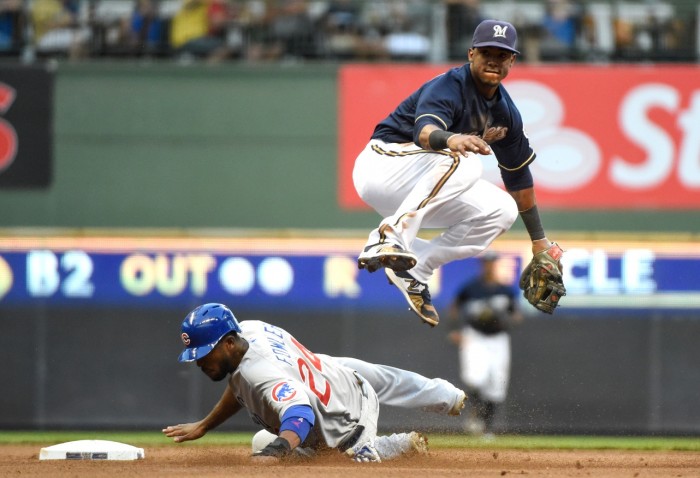The trade deadline has come and gone, and Jean Segura continues to don the Brewers blue. While the team may try to move him during August, it looks as though he’ll stay in Milwaukee for the immediate future. My colleague Derek Harvey has covered Segura’s volatile offense, but I want to turn our attention to his defensive value.
Segura will soon wrap up his third full campaign in the big leagues, around the time when most defensive numbers theoretically stabilize and reflect a player’s true talent. In those seasons, one of the three major metrics — Baseball-Reference’s DRS, FanGraphs’s UZR, and Baseball Prospectus’s FRAA — diverges from the other two in its appraisal of Segura:
| Innings | DRS | UZR | FRAA |
|---|---|---|---|
| 3287.2 | 2.0 | -5.7 | 55.3 |
By DRS, he’s average; by UZR, he’s subpar; but by FRAA, he’s one of the best defensive players in baseball. Since 2013, no shortstop can top him in that regard — second-place Andrelton Simmons, generally thought of as a demigod in the field, owns a “mere” 40.3 FRAA. What does FRAA see in him that the other metrics overlook?
The opaque nature of all three metrics makes in-depth analysis difficult. As an outsider, I don’t have access to the play-by-play breakdown of every ball that Segura has fielded or could have fielded. I can, however, analyze the scouting breakdown that FanGraphs (via Inside Edge) provides. They separate plays into Impossible, Remote, Unlikely, Even, Likely, and Routine, assigning a percentage range to each. Per BP’s glossary, FRAA looks at the average plays made compared to average, setting it apart from other defensive evaluators. Thus, these types of numbers should illuminate Segura’s case.
Over this three-year span, the Inside Edge data has mostly approved of Segura’s defense:
| Player(s) | # 1-10% | # 10-40% | # 40-60% | # 60-90% | # 90-100% |
|---|---|---|---|---|---|
| Segura | 10.0% | 25.6% | 57.4% | 70.6% | 97.9% |
| MLB | 3.7% | 26.9% | 47.2% | 76.7% | 97.2% |
On the Routine plays (which by far occur the most often) Segura’s performed at an above-average rate, to an extent that ranks 12th among 39 shortstops with 1,000 innings. Although they don’t come around as frequently, the Remote plays have gone well for Segura as well. He’s converted five of the 50 that have come to him, second only to wizard Jose Iglesias. And the ones in the middle have him worse than only eight other players. By the other plays, he comes in 17th and 34th, respectively — nothing too inspiring, but not enough to tank his overall value.
Segura, interestingly, has received more plays overall than we’d expect. Put on a per-1,000 inning scale, he’s had 444.7 opportunities, compared to 408.1 for the league-average shortstop. The team’s pitching has somewhat favored ground balls — ranking a respective eighth, 16th, and second in them over the past three seasons — which has presumably helped with that.
We can break the frequency down further and see which kinds of chances the opposing batters have given Segura. As a percentage of possible plays, the easier ones have recurred:
| Player(s) | # 0% | # 1-10% | # 10-40% | # 40-60% | # 60-90% | # 90-100% |
|---|---|---|---|---|---|---|
| Segura | 1.8% | 3.4% | 2.9% | 4.2% | 5.8% | 81.8% |
| MLB | 2.4% | 4.6% | 2.9% | 3.0% | 6.0% | 81.1% |
The Even and Routine plays, at which Segura has excelled, have also shown up more than average. More quantity, as well as more quality, makes for a good combination.
There’s one other characteristic of FRAA that stands out: It centers on play-by-play data. In that way, it’s similar to Total Zone (TZ) runs, the predecessor to all current fielding statistics, which views Segura as a +21 defender from 2013 on — a higher mark than either DRS or UZR. Perhaps this tells us something about the validity of FRAA. If the original, long-trusted defensive statistic concurs with it, maybe DRS and UZR should do so as well.
In the end, I’d assume that Segura’s true fielding ability lies in the middle. The scouts see him as a solidly above-average player with the glove, someone who won’t kill his team but also won’t win any awards. That probably translates to, say, six or seven runs above average per year, which is around where TZ puts him. Compared to most major-league players at the position, that certainly comes out ahead, and would make any player — even one as inconsistent with the bat as Segura — fairly worthwhile.
Segura could become the Brewers’ shortstop long-term, if his three seasons with the team haven’t done so already. The metrics will further scrutinize his defense, and hopefully they’ll begin to agree a bit more (because no one likes a fight). Segura’s done a lot in the field to bring joy to Milwaukee fans, regardless of the numbers he’s posted. More good times should be in store.

These measurements should help deal him. Sure would help if he would hit (and hit with some pop) over the final 6 weeks. That’s assuming that Arcia is ready and the Brewers are willing to bring him up next year. Hope to see him (Arcia) regularly in the last month, but that will make it hard to showcase Seggy.